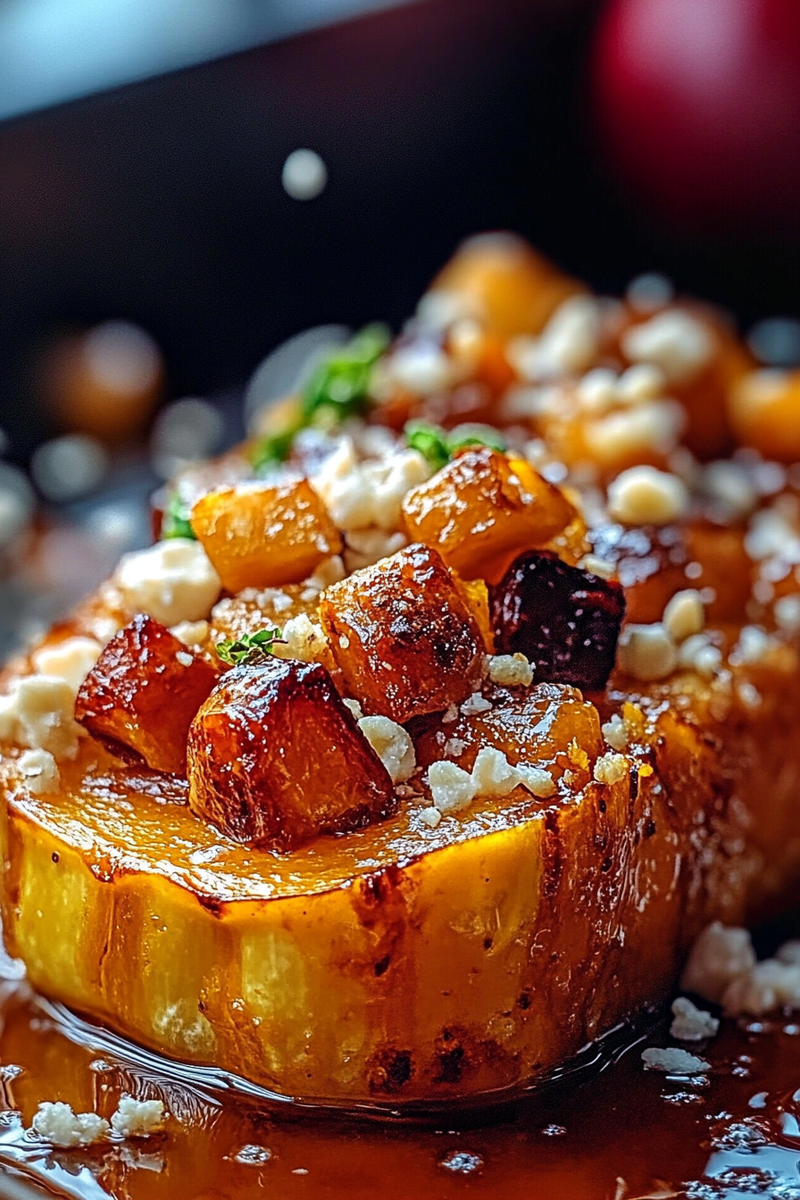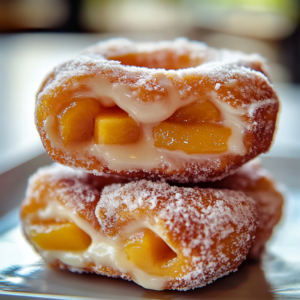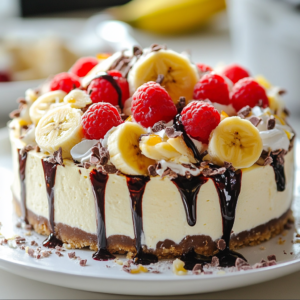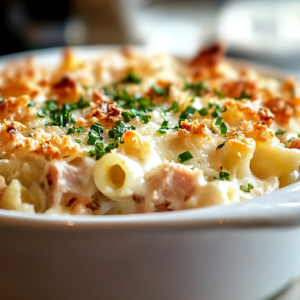Introduction and Quick Summary
Caramelized roasted butternut squash is a delightful dish that combines the natural sweetness of this winter vegetable with a rich, caramelized exterior. This recipe transforms simple ingredients into a delicious side dish that pairs well with various main courses or can be enjoyed on its own as a healthy snack. The process of roasting brings out the butternut squash’s inherent flavors while adding depth through caramelization. You’ll find that this dish not only looks stunning on your dinner table but also offers a warm, comforting taste that is perfect for fall and winter gatherings.

In this article, we will explore everything you need to know about preparing caramelized roasted butternut squash. We will cover the essential ingredients, provide step-by-step instructions to ensure perfect results, and share tips on serving and storing this scrumptious dish. Whether you are an experienced cook or just starting in the kitchen, this guide will help you create a mouthwatering treat that will impress your family and friends. So grab your baking sheet and let’s dive into making some delicious caramelized roasted butternut squash!
Main Ingredients
Butternut Squash
Butternut squash is the star ingredient in this recipe. It boasts a smooth texture and a naturally sweet flavor that enhances when roasted. For this recipe, you will need about 2 pounds of fresh butternut squash. Look for firm squashes without blemishes or soft spots. When selecting your squash, ensure it feels heavy for its size. You can prepare the squash by peeling it with a vegetable peeler and cutting it into bite-sized cubes to ensure even cooking.
Olive Oil
Olive oil plays a crucial role in roasting vegetables as it helps achieve that golden-brown exterior while adding flavor. Use about 3 tablespoons of extra virgin olive oil for this recipe. The high smoke point of olive oil makes it ideal for roasting at high temperatures without burning. Additionally, the healthy fats in olive oil contribute to better absorption of vitamins from the vegetables.
Maple Syrup
For added sweetness and depth of flavor, maple syrup is an essential ingredient in caramelized roasted butternut squash. Use around 2 tablespoons of pure maple syrup to enhance the natural sugars present in the squash. Maple syrup not only gives the dish a rich taste but also adds an appealing glaze that enhances the presentation.
Salt
A good pinch of salt is necessary to elevate all the flavors in your roasted vegetables. About ½ teaspoon should suffice for balancing tastes without overpowering the sweetness of the butternut squash. Using kosher salt or sea salt can add texture and enhance flavor throughout the cooking process.
Pepper
Freshly cracked black pepper adds a hint of spice that complements the sweetness of the butternut squash beautifully. Use approximately ¼ teaspoon for seasoning; however, feel free to adjust based on your taste preferences. The pepper provides warmth and complexity to each bite without overwhelming other flavors.
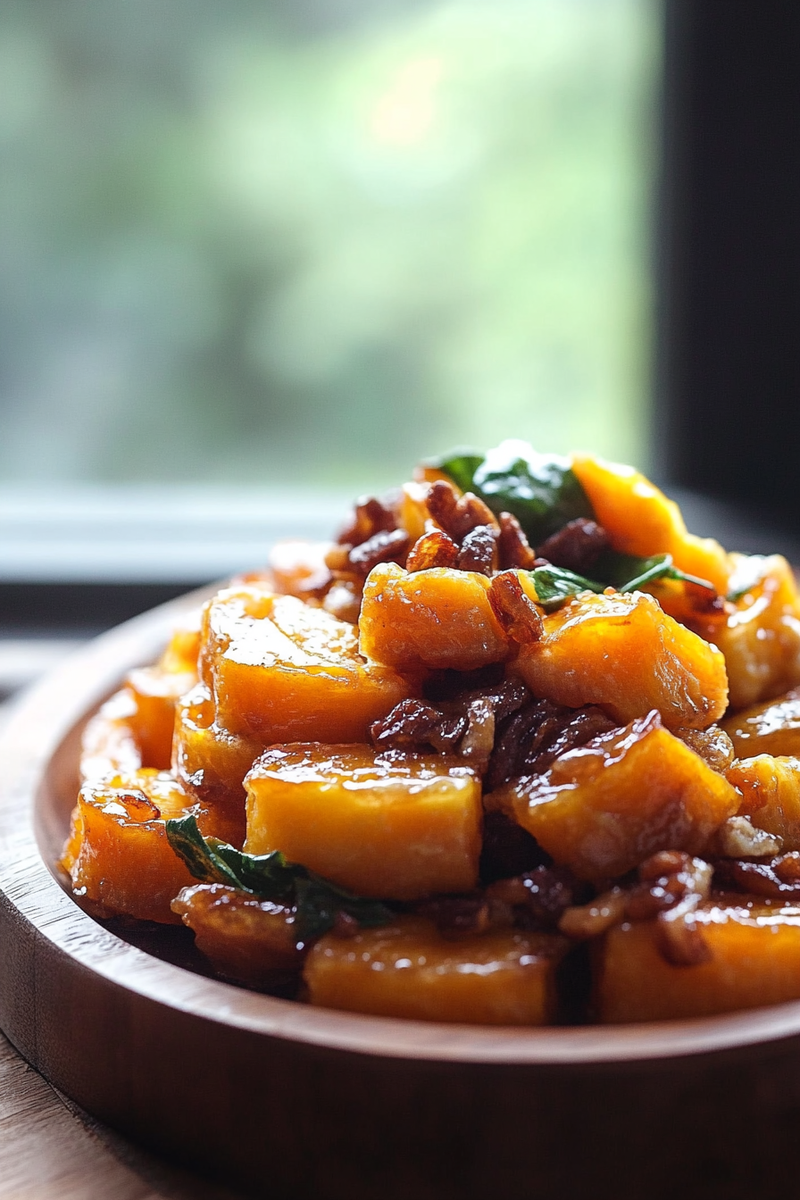
How to Prepare Caramelized Roasted Butternut Squash
Step 1: Preheat Your Oven
Start by preheating your oven to 425°F (220°C). Preheating ensures even cooking throughout the roasting process while allowing sugars within the butternut squash to caramelize effectively. An adequately heated oven creates an ideal environment for achieving that crispy exterior while keeping the interior tender and flavorful.
Step 2: Prepare Your Butternut Squash
While your oven preheats, prepare your butternut squash by peeling it carefully using a sharp vegetable peeler or knife. Cut both ends off first to create stable surfaces before peeling—this technique prevents accidents in case your hand slips while handling it. Once peeled, slice it in half lengthwise and scoop out any seeds with a spoon before cutting into cubes roughly one inch in size.
Step 3: Seasoning The Squash
Place your cubed butternut squash into a large mixing bowl after preparation; then drizzle with olive oil followed by maple syrup. Sprinkle salt and pepper evenly over them as well before tossing all ingredients together until every piece is well coated with oil and seasonings—this step ensures maximum flavor absorption during roasting.
Step 4: Arrange On Baking Sheet
Next up is arranging seasoned pieces onto a parchment-lined baking sheet—ensure they’re spaced out adequately so they don’t steam each other while roasting! Aim for single layers where possible as overcrowding leads to uneven cooking results—some pieces may end up mushy instead of perfectly caramelized!
Step 5: Roast In The Oven
Once arranged properly on your baking sheet, place it in preheated oven for about 25-30 minutes depending on desired tenderness level—you want them fork-tender yet slightly crisped around edges! Halfway through cooking time (around 15 minutes), stir gently once using spatula—this redistributes heat ensuring uniform browning across all sides.
Step 6: Final Touches Before Serving
After removing from oven when done roasting (check with fork!), allow cooling briefly before drizzling remaining maple syrup over top if desired! This last touch enhances overall sweetness making each bite irresistible! Serve warm alongside favorite main dishes like grilled chicken or quinoa salad!
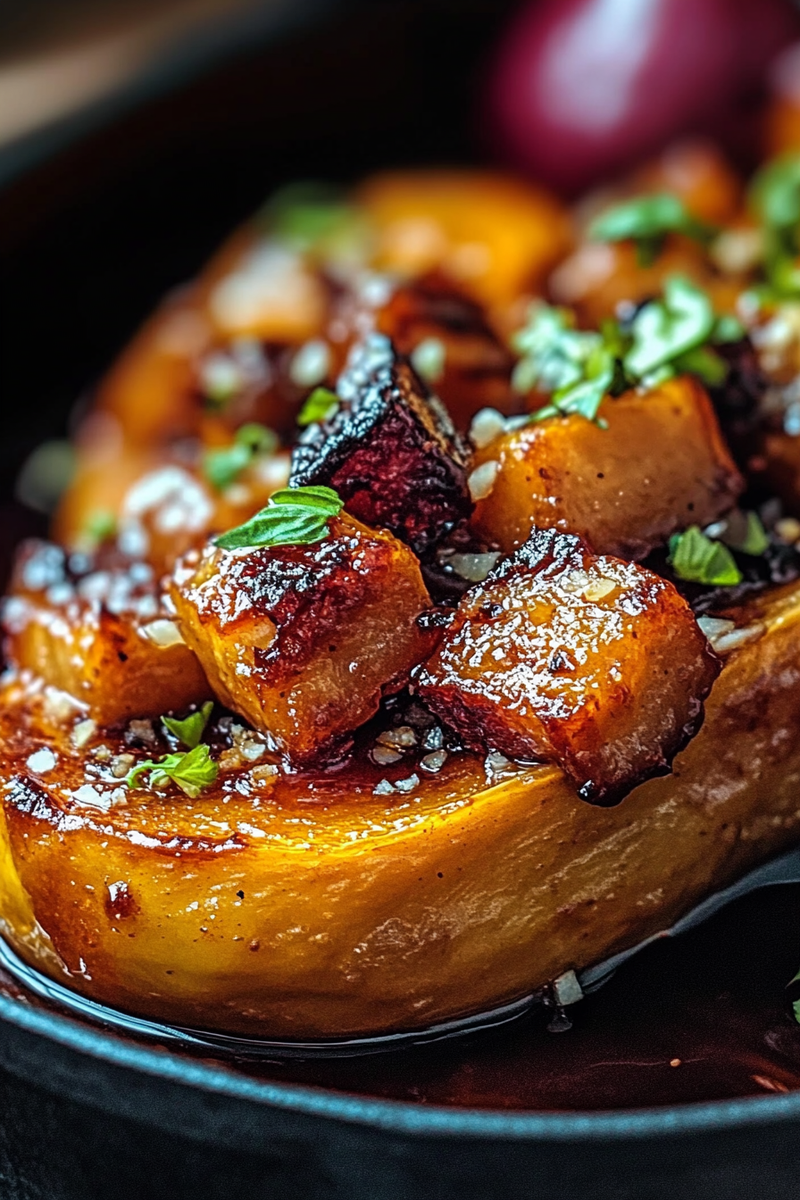
Serving and Storing Tips
Serving Suggestions
Caramelized roasted butternut squash shines as an accompaniment to various meals—its versatility makes it suitable across cuisines! Pair it with proteins such as roast chicken or salmon for balanced nutrition—it complements their flavors perfectly! Alternatively consider adding nuts like walnuts or pecans along garnishing over top providing crunchiness contrast against smoothness within each bite! Consider serving alongside grain salads featuring quinoa or farro too giving hearty fillingness everyone loves!
Storing Leftovers
If you happen to have leftovers after enjoying this delicious dish (which rarely happens!), store them properly for later enjoyment! Allow fully cooled pieces completely cool down before transferring into airtight containers—refrigerated leftovers last up about three days maintaining optimal freshness within those days! Avoid reheating multiple times since doing so impacts texture negatively; instead reheat only what needed either via microwave oven stovetop ensuring even warming throughout!
Freezing Options
For longer storage periods beyond refrigerating options consider freezing cooked pieces instead! Place cooled portions onto baking sheet lined parchment paper; freeze until solid then transfer frozen pieces into freezer-safe bags labeling date contents clearly—this method prevents clumping allowing easy portioning later on! Thaw overnight fridge prior reheating again following same techniques mentioned above ensuring delightful experience every time served fresh made favorite treat guests rave about endlessly!
By following these detailed steps from start finish creating perfect batch flavorful caramelized roasted butternut squashes becomes effortless task anyone can accomplish regardless skill level kitchen expertise possesses—enjoy savoring delightful dish whether shared loved ones alone cozy nights home!
Mistakes to avoid
One of the most common mistakes when preparing caramelized roasted butternut squash is not selecting the right squash. Opting for a squash that is overly mature can lead to a grainy texture and an uneven flavor profile. Choose a butternut squash that feels heavy for its size, with smooth skin and no blemishes. This selection will ensure your dish has the creamy consistency and sweetness that you desire.
Another mistake is improper cutting techniques. If the squash pieces are not uniform in size, they will cook unevenly. Larger chunks take longer to cook than smaller ones, resulting in some pieces being perfectly caramelized while others remain undercooked. Aim for 1-inch cubes to promote even roasting and enhance the dish’s overall appeal.
Overcrowding the baking sheet can also ruin your caramelization efforts. When you place too many pieces on the tray, they steam rather than roast. This steaming effect prevents that delightful golden-brown color from developing. Instead, spread the butternut squash out in a single layer with sufficient space between each piece to allow for proper air circulation.
Failing to season your squash adequately before roasting can lead to bland results. While butternut squash has natural sweetness, it benefits from additional seasoning like salt, pepper, and olive oil. A drizzle of honey or maple syrup can further enhance its flavor during roasting. Don’t hesitate to experiment with herbs such as thyme or rosemary for an added depth of flavor.
Lastly, neglecting to monitor cooking time can lead to burnt or undercooked squash. Roasting times may vary depending on your oven and the size of your pieces. It’s essential to check for doneness by piercing a piece with a fork; it should be tender but not mushy. Regular checks will help you achieve that perfect caramelization without compromising texture.
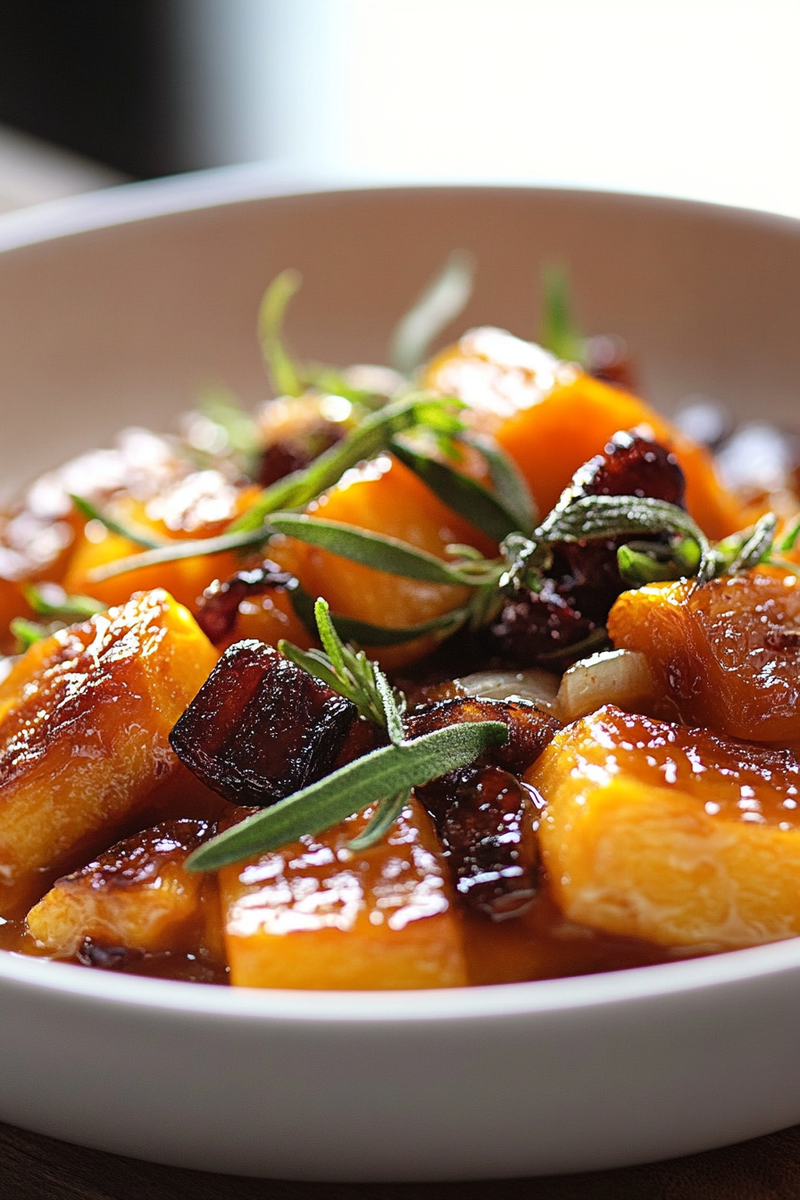
Tips and tricks
To ensure your caramelized roasted butternut squash turns out perfectly, start by preheating your oven adequately before placing your vegetables inside. A hot oven is crucial for achieving that desirable caramelization on the surface of the squash. Aim for a temperature of 400°F (200°C) which promotes browning while keeping the insides tender.
Use high-quality fats for roasting your squash; extra virgin olive oil or melted coconut oil works best. Not only do these oils enhance flavor, they also aid in achieving crispy edges on each piece of squash while adding beneficial nutrients to your dish.
Consider marinating your butternut squash cubes before roasting them for deeper flavors. A simple mix of olive oil, balsamic vinegar, garlic powder, and spices allows the flavors to penetrate better into the flesh of the squash. Allowing it to sit for at least 30 minutes makes a noticeable difference in taste and aroma once cooked.
For an added depth of flavor, incorporate nuts or seeds into your roasting process. Chopped pecans or pumpkin seeds sprinkled onto the baking sheet halfway through cooking add both crunch and nutritional value to your dish without overpowering its natural sweetness.
Experiment with different herbs and spices beyond just salt and pepper; cumin or paprika can introduce an exciting twist while complementing the natural sweetness of butternut squash beautifully. Fresh herbs like cilantro or parsley can make great finishing touches once roasted.
Lastly, don’t forget about presentation! Once removed from the oven, allow your caramelized roasted butternut squash to cool slightly before plating it beautifully alongside other seasonal ingredients such as cranberries or feta cheese crumbles—this adds visual interest and elevates your meal.
Suggestions for Caramelized Roasted Butternut Squash
When making caramelized roasted butternut squash, consider pairing it with complementary flavors that enhance its sweetness and creaminess. For instance, serving it alongside savory proteins like grilled chicken or pork creates a well-rounded meal that balances flavors effectively.
Incorporating grains like quinoa or farro into your serving suggestion can elevate both texture and nutrition levels within this dish as well! Tossing some cooked grains together with roasted squash yields an exquisite salad base that’s not only healthy but visually appealing too.
For those who enjoy bold flavors, consider adding tangy elements such as feta cheese or goat cheese crumbles after roasting; their creamy texture contrasts wonderfully against the sweet notes from caramelization while providing an extra layer of complexity in taste!
Dressing up roasted butternut squash with fresh herbs like sage or thyme enhances its aroma significantly—simply sprinkle some chopped herbs over your dish right before serving! This trick brings freshness into every bite while harmonizing beautifully with other ingredients present on your plate.
If you want an even sweeter treat after preparing this recipe try drizzling balsamic glaze over finished servings; this adds both elegance and depth without overwhelming existing flavors within each piece!
Finally—don’t forget about versatility! Use leftover roasted butternut squash in soups or purees; blending them down creates delicious comfort meals perfect for chilly evenings ahead!
